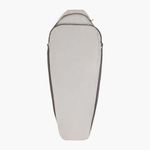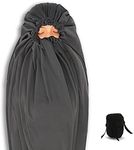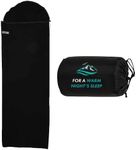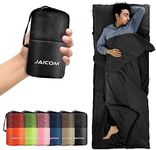Buying Guide for the Best Sleeping Bag Liners
Choosing the right sleeping bag liner can make a big difference in your comfort, warmth, and hygiene while camping or traveling. A liner acts as a barrier between you and your sleeping bag, helping to keep your bag clean, add extra warmth, and sometimes even serve as a lightweight sleeping option on its own. To find the best fit for your needs, it's important to understand the key features and how they relate to your intended use, whether that's backpacking, hostel travel, or car camping.MaterialThe material of a sleeping bag liner determines how it feels against your skin, how much warmth it adds, and how easy it is to care for. Common materials include cotton, silk, synthetic fabrics, and blends. Cotton is soft and breathable but can be bulky and slow to dry, making it better for car camping or hostels. Silk is lightweight, compact, and comfortable, ideal for backpackers who want to save space and weight. Synthetic materials dry quickly and are often more durable, making them good for humid or wet conditions. To choose the right material, think about your priorities: if you want warmth and luxury, silk or fleece might be best; if you need something easy to wash and quick to dry, go for synthetic.
ShapeSleeping bag liners come in different shapes, such as rectangular, mummy, or double. Rectangular liners offer more room to move and are great for use in hostels or with rectangular sleeping bags. Mummy-shaped liners are tapered to fit inside mummy sleeping bags, reducing excess fabric and maximizing warmth. Double liners are designed for two people or extra space. To pick the right shape, match it to your sleeping bag or your personal comfort preference—if you toss and turn, a rectangular liner may be more comfortable, while a mummy liner is better for warmth and weight savings.
Warmth (Thermal Rating)Some liners are designed to add extra warmth to your sleeping setup, and this is often indicated by a thermal rating or a claim of how many degrees they can add. Lightweight liners add minimal warmth and are mainly for hygiene, while thermal or insulated liners can add significant warmth, making them suitable for colder conditions. If you camp in cold weather, look for a liner with a higher thermal rating; if you mostly travel in warm climates, a basic liner will suffice.
Weight and PackabilityThe weight and packability of a liner are important if you plan to carry it in a backpack or suitcase. Lightweight and compact liners are easier to pack and carry, making them ideal for backpackers and travelers. Heavier or bulkier liners may offer more comfort or warmth but are better suited for situations where you don't have to carry your gear far. Consider how much space and weight you can spare in your pack when choosing a liner.
Ease of CareHow easy it is to wash and dry your liner can be important, especially on longer trips. Some materials, like cotton and synthetic, are machine washable and dry quickly, while others, like silk, may require more delicate care. If you expect to wash your liner frequently, choose one that is easy to clean and dries fast to avoid hassle during your travels.
Added FeaturesSome liners come with extra features like pillow pockets, insect-repellent treatments, or antimicrobial coatings. Pillow pockets allow you to insert a pillow or clothing for extra comfort, while insect-repellent or antimicrobial treatments can be useful in tropical or humid environments. Think about where and how you'll use your liner to decide if these features are important for you.
















